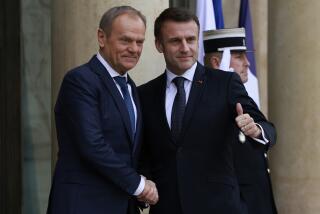Europe debt crisis plan hinges on economic growth
The latest plan to save Europe from its debt crisis was greeted with a burst of self-congratulation from the bleary-eyed leaders who negotiated it and a respite from the months of pounding by the continent’s financial markets.
But the politicians who struck an early-morning deal in Brussels to avert financial collapse still face another ominous threat: a slide back into recession for their economies that could undermine the debt agreement as well as bring even greater social disorder to their streets.
The realization appears to be taking hold in some capitals that any “grand plan” to restore confidence in the Eurozone will fail without accompanying economic growth. Cuts in government spending that have been prescribed to get budget deficits under control also lead to job losses, along with the hardship and fear that foment social unrest.
Evidence is already coming in. From riots in Britain to peaceful protests by thousands of youths in Spain, from the angry unions marching through tear gas in Greece’s streets to the far-right populist parties surging in popularity in the Netherlands and Scandinavia, the consequences of a hard economic squeeze are creating a backlash on the streets and making governments nervous.
Though lacking the attention paid to the debt conflagration, the quest to spur growth was also on the agenda for this week’s two summits of European Union leaders. Yet despite worrisome signs in the last few weeks that even the German economy, Europe’s powerhouse, is stalling, the discussions have yet to produce any policy shifts or breakthroughs in creating jobs or hiking demand.
“What you see across Europe is the recognition that the lack of growth is a problem. I’d like to tell you that therefore they’d do something about it, but I’m afraid I can’t,” Alistair Darling, a former British finance minister, said in a telephone interview.
“They’re right to be talking about growth, because unless they get the economy going and arrest this slide into a slump, there’s no chance of getting public finances across the union under control,” added Simon Tilford, chief economist at the Center for European Reform, a London-based think tank. But “it’s not so far showing up in terms of a change in strategy.”
Even the International Monetary Fund, a stickler for fiscal discipline and a participant in Europe’s bailouts of Greece, Portugal and Ireland, has begun admonishing European governments to do more to stimulate growth, not just slash spending. In Britain, for example, which is undergoing its most brutal austerity cuts in a generation, the IMF has in effect called on the Bank of England to print more money to help jump-start the economy if it sputters badly.
The sense of urgency was heightened this week by data suggesting that the 17-nation Eurozone, which includes both Germany and France, is in danger of tipping from stagnation into recession. Factory orders have fallen, and the service sector has shrunk. Business confidence has plunged.
Some of the pessimism no doubt stemmed from the ongoing debt crisis and skepticism that leaders would at last find a durable solution. On Thursday, Europe’s major stock markets all posted dramatic gains on the strength of the crisis strategy unveiled in Brussels after marathon negotiations.
Whether those gains are more than fleeting remains to be seen. Previous announcements of new crisis measures also have resulted in market boosts, which then fade as analysts and investors pick over the fine print.
In the latest case, the fine print is not yet available. The leaders emerged with a broad agreement on three main elements of the rescue plan but acknowledged that many of the details remain to be worked out over the coming weeks by officials.
The most important plank — increasing the size and power of Europe’s partially depleted $600-billion bailout fund — fell short of what many analysts said was necessary to assure investors the Eurozone could protect economies the size of Italy and Spain from market pressures. There was no precise figure on how big it will become (though most estimates put it at about $1.4 trillion), and the plan focuses on stretching its resources further by making the fund an insurer of countries’ bonds rather than purchasing them outright.
The idea is to make the money in the current fund go further because Germany has said it will not increase its contribution. France, the other main supplier to the fund, fears its own credit rating could be at risk if it is forced to ante up more funds.
Separately, officials want to set up a special account within the bailout fund that would attract money from international investors such as sovereign wealth funds. French President Nicolas Sarkozy called Chinese leader Hu Jintao on Thursday to sound out Chinese interest, though the Chinese have previously made clear their reluctance to make any direct investment.
The world’s richest trading bloc, the EU, is now asking poorer countries to help ease its pain.
“It smacks of desperation,” Tilford said.
Other parts of the rescue package were also short on detail about the mechanics. Intense German pressure on banks holding Greek government debt led to an apparent agreement to cut the face value of Greek bonds by 50%. But participation by the banks is voluntary and may depend on a complicated set of “sweeteners” that would accompany a re-issuing of the Greek bonds. Those details are not settled.
And while the decision to increase the write-down of Greek bonds is a welcome one for Athens, it still leaves the government with a projected debt burden of 120% of gross domestic product in 2020. That is the same level that’s ringing alarm bells in Italy now.
Still, the new crisis plan was hailed as an important step forward in many quarters, including Germany, where the national media heralded Chancellor Angela Merkel’s tough line on the banks. Merkel achieved almost all her objectives at the EU summit, overriding objections from France and private bondholders and establishing Germany unquestionably as the country calling the shots in the crisis.
“The world celebrates Angela Merkel,” the bestselling German tabloid Das Bild declared on its website, adding with a dose of chauvinism: “Only the Greeks bad-mouth our chancellor.”
But Merkel is also faced with a domestic economy that has in effect flat-lined in recent months. And her country is coming under fire for not doing enough to stimulate demand, to get Germans to open their wallets and spend, which would help revive Europe’s moribund economies.
Instead, for all the rise in rhetoric recently on the need to foster growth, northern European nations such as Germany and the Netherlands continue to insist that their southern neighbors implement ever-harsher austerity programs to reduce their deficits.
“I have the impression that what came out of the summit was a desire to reinforce austerity measures, which is pretty dramatic, because we are seeing that [some] economies can’t handle budgetary tightening,” said Mathieu Plane, an economist at the Paris Institute of Political Sciences.
Fiscal discipline remains the dominant narrative in the EU, because “Germany has the position of strength in Europe,” he said.
Yet without growth, debt-ridden nations such as Greece and Italy will find it even more difficult to raise the revenue to pay off what they owe. Already, deep cuts have caused a major contraction in the Greek economy, with a return to growth looking increasingly uncertain in the Mediterranean nation.
The wrenching downturn has sparked a series of general strikes and violent demonstrations on the streets of Athens, underlining the dangers posed if things don’t change.
“There’s no doubt that particular governments understand that growth is key,” said Tilford. “But it’s far from clear that they’ve learned the lessons of the Greek debacle.”
Special correspondent Devorah Lauter in Paris contributed to this report.
More to Read
Start your day right
Sign up for Essential California for news, features and recommendations from the L.A. Times and beyond in your inbox six days a week.
You may occasionally receive promotional content from the Los Angeles Times.







